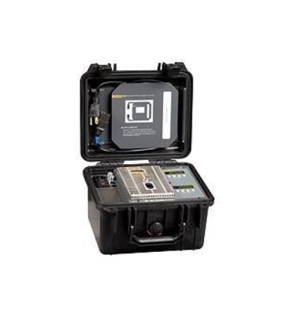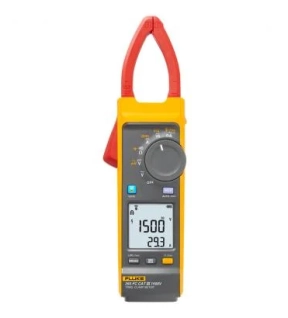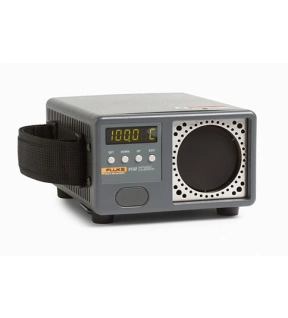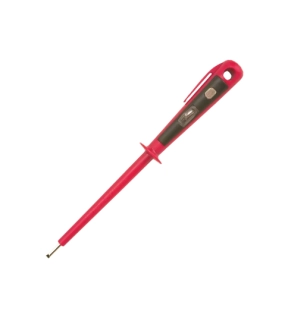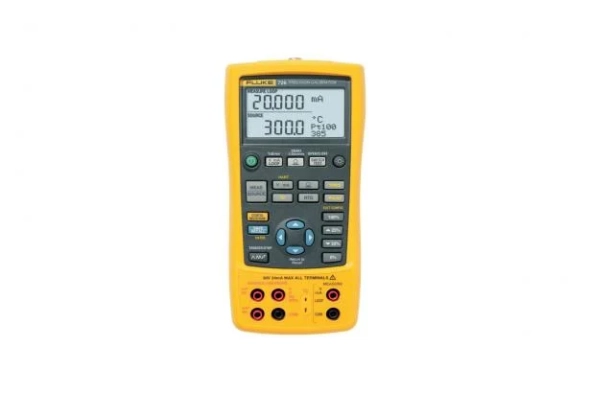
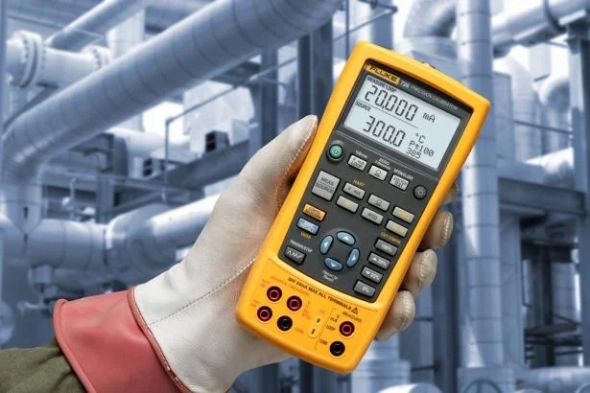
Measuring Tools
Fluke 726 Precision Multifunction Calibrators
Process calibration designed specifically for process industries
The Fluke 726 is a precise and powerful, yet easy-to-use, field calibrator. It features broad workload coverage, calibration power, and unsurpassed accuracy needed by process professionals. It measures and sources almost all process parameters to calibrate almost anything. Use it to test sensors and valves, and to test and calibrate transmitters. The 726 interprets results without the help of a calculator and stores measurement data for later analysis.
Measurement capabilities
This precision multifunction calibrator measures volts, mA, pressure, RTDs, thermocouples, frequency, and resistance to test sensors and transmitters. The 726 also sources and simulates volts, mA, thermocouples, RTDs, frequency to calibrate transmitters. Measures and/or sources pressure using when paired with any of the 50 Fluke 750P series Pressure Modules to test and calibrate pressure transmitters and other devices. The 726 can also:
- Source mA with simultaneous pressure measurement to conduct valve and I/P test
- Conduct enhanced flowmeter testing with frequency totalizer and frequency pulse train source mode
Designed for ease of use
The 726 has built-in features that make it easier to use in nearly any measurement situation. From its ability to store frequently used test setups, to programming custom RTD probe calibration constants for enhanced temperature measurement, or the integrated voltage input protection design that improves reliability, the 726 is built to perform. The use of two separate channels even allows you to measure, source, or view process signals simultaneously. The backlit display provides better visibility in low-light conditions, and the standard 3-year warranty provides extra confidence that the 726 will be there when you need it to be.
You can also use the 726 to:
- Capture the set, reset, and deadband of a pressure switch with the integrated switch test
- Calculate the transmitter error % to interpret calibration results without the use of a calculator
- Perform fast linearity tests with the auto-step and auto-ramp features
- Power a transmitter during test using 24 V loop supply and simultaneous mA measurement
The Fluke 726 is a precise and powerful, yet easy-to-use, field calibrator. It features broad workload coverage, calibration power, and unsurpassed accuracy needed by process professionals. It measures and sources almost all process parameters to calibrate almost anything. Use it to test sensors and valves, and to test and calibrate transmitters. The 726 interprets results without the help of a calculator and stores measurement data for later analysis.
Measurement capabilities
This precision multifunction calibrator measures volts, mA, pressure, RTDs, thermocouples, frequency, and resistance to test sensors and transmitters. The 726 also sources and simulates volts, mA, thermocouples, RTDs, frequency to calibrate transmitters. Measures and/or sources pressure using when paired with any of the 50 Fluke 750P series Pressure Modules to test and calibrate pressure transmitters and other devices. The 726 can also:
- Source mA with simultaneous pressure measurement to conduct valve and I/P test
- Conduct enhanced flowmeter testing with frequency totalizer and frequency pulse train source mode
Designed for ease of use
The 726 has built-in features that make it easier to use in nearly any measurement situation. From its ability to store frequently used test setups, to programming custom RTD probe calibration constants for enhanced temperature measurement, or the integrated voltage input protection design that improves reliability, the 726 is built to perform. The use of two separate channels even allows you to measure, source, or view process signals simultaneously. The backlit display provides better visibility in low-light conditions, and the standard 3-year warranty provides extra confidence that the 726 will be there when you need it to be.
You can also use the 726 to:
- Capture the set, reset, and deadband of a pressure switch with the integrated switch test
- Calculate the transmitter error % to interpret calibration results without the use of a calculator
- Perform fast linearity tests with the auto-step and auto-ramp features
- Power a transmitter during test using 24 V loop supply and simultaneous mA measurement
Download
Produk Lainnya
Fluke 9009 Industrial Dual-Block Thermometer Calibrator
Double your productivity or cut your calibration time in half
• Temperatures from –15 °C to 350 °C in one unit
• Two wells in each block for simultaneous comparison calibrations
• Rugged, lightweight, water-resistant enclosure
You’ve been asking for it and now we’re making it for you. The Model 9009 Industrial Dual-Block Calibrator lets you calibrate at hot and cold temperatures at the same time. Double your productivity or cut your calibration time in half—either way you look at it, your in-field temperature calibrations just got easier.
• Temperatures from –15 °C to 350 °C in one unit
• Two wells in each block for simultaneous comparison calibrations
• Rugged, lightweight, water-resistant enclosure
You’ve been asking for it and now we’re making it for you. The Model 9009 Industrial Dual-Block Calibrator lets you calibrate at hot and cold temperatures at the same time. Double your productivity or cut your calibration time in half—either way you look at it, your in-field temperature calibrations just got easier.
Fluke 393 Solar Clamp Meter CAT III 1500 V
The Fluke 393 FC CAT III 1500 V True-rms Solar Clamp Meter with iFlex is designed for solar photovoltaic (PV) installation technicians and maintenance professionals who work in high voltage DC environments: PV arrays, wind power, electric railways, data centers battery banks for uninterruptible power supplies. The clamp meter will measure up to 1500 V DC and 1000 V AC with test leads, and up to 999.9 A DC or AC through the clamp jaw. The included iFlex flexible current probe extends AC current measurements up to 2500 A. The 393 has a thin jaw, giving you access to cables in crowded combiner boxes. Plus, the test leads are designed with your work in mind, and are also rated to CAT III 1500 V DC.
Key functions of the solar clamp meter:
- IP54 rated, ideal for work outdoors including PV panel testing
- DC power measurement, showing readings in kVA
- Audio Polarity indicator helps prevent accidental miswires
- Visual Continuity provides a bright green light in the display, ideal when working in dark and noisy environments
- Logging and reporting of test results via Fluke Connect software
- When measuring ac current the included iFlex flexible current probe gives you unparalleled access to cable is tight spaces. The iFlex probe can be twisted through extremely small spaces and provide accurate current measurements.
The world's first CAT III 1500 V true-RMS solar clamp meter
Key functions of the solar clamp meter:
- IP54 rated, ideal for work outdoors including PV panel testing
- DC power measurement, showing readings in kVA
- Audio Polarity indicator helps prevent accidental miswires
- Visual Continuity provides a bright green light in the display, ideal when working in dark and noisy environments
- Logging and reporting of test results via Fluke Connect software
- When measuring ac current the included iFlex flexible current probe gives you unparalleled access to cable is tight spaces. The iFlex probe can be twisted through extremely small spaces and provide accurate current measurements.
The world's first CAT III 1500 V true-RMS solar clamp meter
Fluke 9132 and 9133 Portable Infrared Calibrators
Precision when you need it for infrared temperature calibration
Fluke 9132 and Fluke 9133 Portable Infrared Calibrators features:
• Certify IR pyrometers from –30 °C to 500 °C (–22 °F to 932 °F)
• Large 57 mm (2.25 in) blackbody target
• RTD reference well for contact temperature measurement
• Small, compact design in a blackbody calibrator
Whether you’re using in-line or handheld infrared pyrometers, you need good calibration standards to verify their accuracy. Our portable IR calibrators provide stable blackbody targets for calibrating noncontact IR thermometers from –30 °C to 500 °C.
These blackbody calibrator units feature a temperature controlled measurement surface with a diameter of 2.25 in (57 mm). The target temperature can be controlled in set-point increments of 0.1° from –30 °C to 500 °C and a well is located directly behind the blackbody surface for contact temperature measurement.
Fluke 9132 and Fluke 9133 Portable Infrared Calibrators features:
• Certify IR pyrometers from –30 °C to 500 °C (–22 °F to 932 °F)
• Large 57 mm (2.25 in) blackbody target
• RTD reference well for contact temperature measurement
• Small, compact design in a blackbody calibrator
Whether you’re using in-line or handheld infrared pyrometers, you need good calibration standards to verify their accuracy. Our portable IR calibrators provide stable blackbody targets for calibrating noncontact IR thermometers from –30 °C to 500 °C.
These blackbody calibrator units feature a temperature controlled measurement surface with a diameter of 2.25 in (57 mm). The target temperature can be controlled in set-point increments of 0.1° from –30 °C to 500 °C and a well is located directly behind the blackbody surface for contact temperature measurement.
Kennedy Euro Tester - 150mm
With heavy duty one-piece moulded insulation sheaths covering both blade and transparent plastic handle for extra protection and safety. Will detect 'live' electricity supply. Suitable for AC to 125 - 250V. 3mm wide tip. Conforms to DIN VDE 0680 part 6:1977-04.


